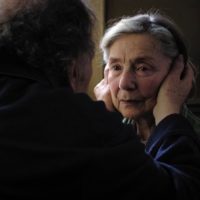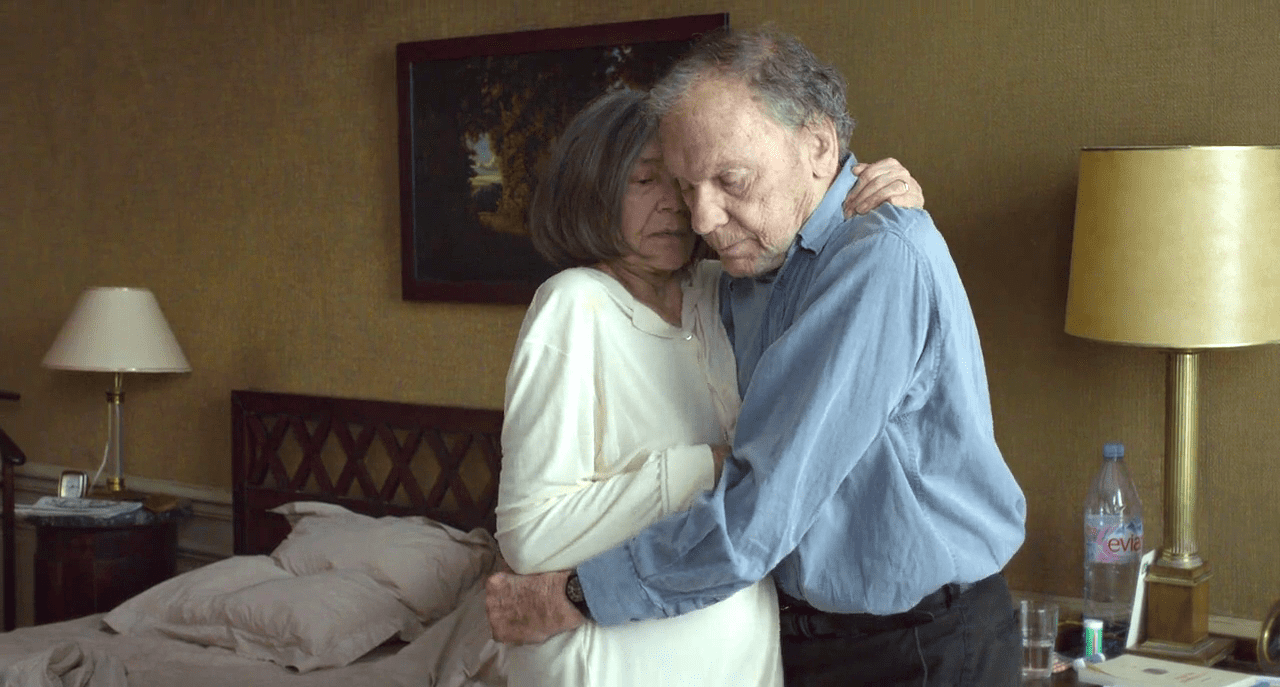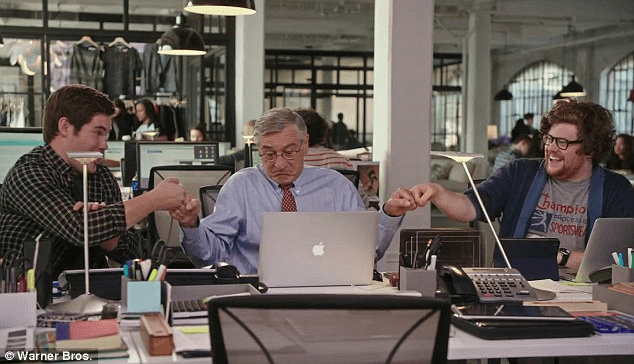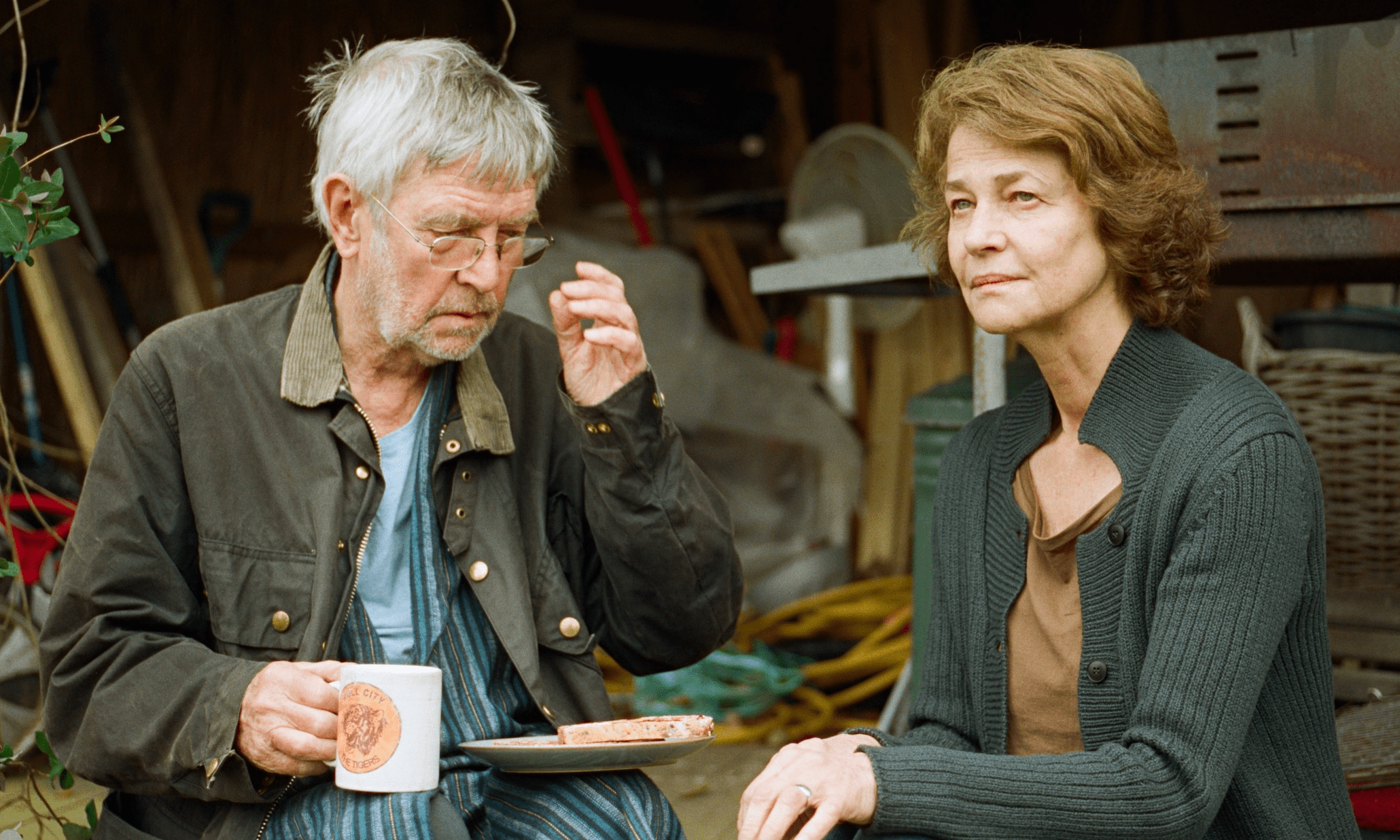Michael Haneke’s 2012 Amour begins with a piano recital. Before Schubert’s Impromptu, Op. 90 in G-Flat Major consumes the theater, Haneke rests the camera’s gaze upon the audience. We hear the sound of whispers and chattering, of latecomers shuffling through the rows of seats, of breathing and shifting, and, ultimately, of clapping in preparation for the impending concerto. Yet when the Impromptu begins, the camera lingers on the audience, and for a moment, the music feels like a disruption to those small sounds of the living.
This opening scene sets the tone for Amour, an unconventional love (or some may say horror) story of two elderly spouses, Anne and Georges, toward the end of their life. As the couple returns home from their night at the theater, they notice their door lock disfigured by an attempted intruder, an unsettling disturbance to their safe space. Following this ill omen, their sense of security continues to dissolve when Anne suffers a stroke the next day. Paralyzed from the right side down, Anne’s health slowly declines over the film’s two hours as we watch Georges care for her—feed her, lift her, shower her, wipe her, read to her, sing to her, slap her, and, eventually, asphyxiate her.
The film’s final scenes show Georges smothering his suffering wife with a pillow. Although left somewhat ambiguous, Georges dies in the end as well, to join Anne elsewhere, and Amour closes on a completely silent shot of their home. A silence more beautiful and more serene than Schubert. A silence that ushers the couple out of the world.
My viewing of Amour was a difficult experience for reasons beyond its troubling content. An ill-equipped Spanish speaker, I sat uneasily inside a megaplex in Santiago, Chile, where I had lived for the past three months, as the lights dimmed for the screening of this French art house film. The opening credits began to roll, first in French, then at the bottom of the screen in yellow Spanish subtitles, and eventually adapted by my brain into English.
Amour is lauded for its realistic exposition of the physical and emotional weight of aging. As I watched thrice removed linguistically, I also became cognizant of the layers of separation between Anne—an elderly woman who could no longer move or communicate at a customary pace—and me, a healthy, able-bodied young woman. Both language and plot became deep challenges for translation.
The film calls to mind feminist and geriatric philosopher Lynne Segal, who constantly challenges what it means to be elderly: “As we age, changing year on year, we also retain in one manifestation or another, traces of all selves we have been, creating a type of temporal vertigo and rendering us psychically, in one sense, all ages and no age.”1 Or as Joan Didion more universally and less abstractly puts it, “I think we are well advised to keep on nodding terms with the people we used to be, whether we find them attractive company or not.”2
And this is where my translation of Amour became muddled. In the same way I was losing meaning from French to Spanish to English, I couldn’t help but think about how depictions of the elderly as only suffering elide the rich fabric of their many past selves. It is not uncommon for films featuring the elderly to serve as reminders of our mortality, of the gradual and prolonged pain we will surely encounter as we grow closer to death (think Nebraska, Frank and the Robot, The Notebook). While declining health is a real and relatable narrative to many elderly, by failing to view aging through any other lens, we neglect their other selves, their ageless beings, transforming them into mere symbols rather than characters. There is a reason I don’t confine myself exclusively to watching media of overly anxious, depressed white girls in their twenties floundering in their professional and personal lives (although I do love Girls). I seek out visions of women unlike myself, and I hope others do the same so as to construct a more nuanced understanding of what it means to be a woman. The elderly deserve the same.
In the words of Segal, it is very difficult to “come out” as old given the dismissal and invisibility that goes hand in hand with the inevitable process of aging. While there have been some strides in this arena (Grace and Frankie, Grandma), Nancy Meyers’s most recent dramedy, The Intern, flips the monotonous pop culture image of the elderly on its head. Meyers plunges us into a world where the corporeality of the elderly is secondary to their character.
The Intern opens on a more Millennial type of performance than that of Amour’s piano recital—a Tai Chi meditation class in Brooklyn’s Prospect Park. The camera pans to Ben Whittaker, a tranquil seventy-year-old played by Robert De Niro, executing each movement with precision. On his way home from class, Whittaker notices an ad for a senior citizen internship program, and soon becomes the disciple of Jules Ostin (Anne Hathaway), CEO and founder of About the Fit, an online retail fashion platform.
About the Fit is a quintessential start-up, a lovechild of Google and Facebook, so on the nose it is difficult to tell if Meyers is mocking youth culture or truly believes it to be that utopic. Located on the top floor of an abandoned warehouse, natural light floods the office, which is dotted with shared workspaces, slick Apple desktops, lounging areas, and even a house masseuse. Most perplexingly, Ostin is seen riding her bike up and down the rows of desks, in an office that certainly does not exceed two hundred square feet.
Although we frequently think of the elderly as hesitant to embrace the technological revolution, there is nothing antiquated about Ben aside from his conspicuous chivalry. He eagerly embraces the new environment, earning the title of Mr. Congeniality—befriending his younger male counterparts and proving himself as a capable and motivated worker. Jules is initially reticent to mentor Ben, as she is swamped with work—struggling with the exponential growth of her business and the external pressure from investors to find a more experienced CEO—and overwhelmed by her family life in caring for her child and repairing the relationship with her straying husband.
Some have viewed this film as unsuccessfully proselytizing Sheryl Sandberg’s so-called-feminist “lean in” trope. Jules is a walking bundle of platitudes about gender equity in the workplace, embodying the modern-day woman just trying to “have it all.” Yet, the only feminist element of the film is the simple fact that a woman is seen in a position of power, which is quickly diluted by Ostin’s outdated reliance on male validation and nostalgia for archaic gender roles. This is most glaring when Ostin gets drunk one night and laments that Jack Nicholsons and Harrison Fords, men from the age of gallantry, have given way to weaker, more feminine bums—like her coworkers. She admires men like Ben who carry around handkerchiefs, just in case a woman needs something to wipe the tears away (yikes!). And eventually, rather than proposing alternative visions of how women are meant to balance motherhood and professional life, Ostin does succeed at magically having it all. Not to mention that the film’s “progressive” landscape seems to consist of only white millennials with a few insensitive bipolar jokes sprinkled throughout.
But to be honest, none of this matters. The film is ultimately not about Anne; it is about Ben. It is called The Intern, not The CEO, after all. This film has little to do with Sheryl Sandberg’s notion of leaning in, and everything to do with a lean in for the elderly. Through an undercurrent of neoliberal rhetoric, The Intern showcases the workplace as the locus of meaning in life. Before Ben became an intern at About the Fit, he was dissatisfied with retirement, hit on by women he found unappealing, and invited to boring affairs. Similar to The Office, The Intern portrays work as a catalyst not simply for productive professional pursuits, but for friendships, relationships, and even fun and silly shenanigans.
On the first day of his internship, Ben almost immediately gets a boner upon meeting the house masseuse, signaling a metaphorical and concretely sexual revival. A younger male coworker then exchanges an understanding look and passes him a newspaper to cover up his bulging zipper. It only takes two minutes for this intergenerational group to share the core elements of masculine homo-social relations, reinvigorating Ben’s monotonous life. Ben goes on to befriend three male coworkers with whom he dishes out gossip, offers advice on winning back girlfriends, and shares tips for dressing sleek at the office. The four of them even venture on a ridiculous mission to steal a computer from Ostin’s mom’s house in a scene of such contrived rebellious revelry it is hard not to find yourself indulging in the corniness of it all. Through a number of these small acts, Ben wins Jules and the entire office over with his endearing and paternal antics, and eventually proves himself to be a great intern, friend, and confidant.
Nancy Meyers is one of the only filmmakers currently redefining our understanding of the “utility” of the elderly. By bringing the elderly into this world, Meyers demonstrates that they are not obsolete, nor sources of imminent economic drain, but rather capable, functioning members of the increasingly technological 21st century when given the opportunity. Meyers even sticks in a quick Facebook tutorial for all the elderly audiences watching. It’s not as in-depth coverage as in the movie Chef, which laid out the full youth media space in ninety minutes under the guise of a modern food truck road movie, but it’s enough to keep an older audience informed and included.
And despite its lighter tone, The Intern still manages to touch on the ubiquity of death. About two thirds in, Ben asks out the house masseuse (played by Rene Russo, a sexagenarian babe) on a date, which due to unforeseen circumstances, is set to occur the same day as an acquaintance’s funeral. Rather than cancelling, Ben and the masseuse stop by the funeral and then proceed with their planned outing. Although seemingly insignificant, this scene shows that for the aging, funerals are not rare but routine. While both Amour and The Intern present death as an element of daily life, the first tracks the deterioration of the body and the latter examines how recurring death redefines (but does not eliminate) our social behavior. The Intern normalizes funerals, asking us to see them not simply as a space for shared sadness and compassion but as a recurrence intimately intertwined with our joyful moments, like taking a woman out on a date.
As in It’s Complicated (2009) and Something’s Gotta Give (2003), this is Nancy Meyers’s forte. She creates realities in which older people share the same world, the same desires, the same activities, and the same challenges as the young. Ben is not dying, he is not suffering from a chronic illness, he is not losing his memory. Yes, he represents a traditional ideology, but he is functioning in and contributing to a sphere centered around newness, youth, technology, and innovation. Ben is a character, not a walking emblem of death and decay.
There are contemporary films attempting to offer a middle ground to the morose realism of Amour and the spritely optimism of The Intern. Perhaps the most recent of this category is the critically acclaimed Oscar contender 45 Years—Andrew Haigh’s newest drama unfolding over the one week that husband and wife Geoff (Tom Courtenay) and Kate (Charlotte Rampling) prepare for their forty-fifth wedding anniversary party. After unexpectedly receiving a letter notifying that the body of Geoff’s old lover Katya was recently discovered in a glacier, he and Kate are then thrust into the past as secrets about a youthful flame are revealed and a decades-long love begins to feel founded on lies and omissions. As Geoff and Kate must confront their current and past selves, Segal’s notion of “temporal vertigo” is explicitly present.
Halfway through the film there is a moment when Geoff, increasingly obsessed with climate change, explains that an iceberg will build on itself over time until one day it comes crashing down like a tsunami. 45 Years culminates in the quiet tsunami of Geoff’s and Kate’s relationship, as we see how even after decades of living with someone, loneliness can rear its head, and the choices made in your youth can continue to haunt old age.
45 Years is a beautiful reflection on the delicacy of love and memory, as we bear witness to an eroding relationship that vacillates between affection and performance. And while some moments are palpably sad, others belie our assumptions of older life. Neither Geoff nor Kate is influenced by specifically decaying brains or bodies, only by the general malaise of a wearing frame. Their libido is present, although not always in line with their body’s capabilities. They drink and dance, meet up with friends for coffee and reunite with old co-workers to exchange stories. Despite years of living with the same companion, cultivating the same long-lasting friendships, and working the same jobs, Geoff and Kate still encounter drama, excitement, and sorrow. They lead a life of bourgeois comfort distinct from their youth, but similarly tempestuous and vivacious. It may not read as an anti-ageism manifesto like The Intern, but 45 Years sufficiently situates the elderly within a complex narrative outside of illness.
Roger Michell’s Le Week-End (2014), Martha Stephens’s Land Ho! (2014), and even Michael Showalter’s Hello, My Names is Doris (2016) are all similarly pushing the boundaries of geriatric cinema, straddling the line between existential reflection and amusement. Despite some of the more nuanced alternatives, it remains comforting to see a commercially accessible film like The Intern so adroitly challenge our conventions around intergenerational relationships. Amour must exist, but only alongside the above films, probing our current translations of aging life.
Just as silence ushers us out of Amour, and quiet introspection caps 45 Years, The Intern closes on the tranquility of the Tai Chi class, lingering on Ben and Ostin, old and young, conducting their movements in tandem. The aged and ageless become one. The elderly become reminders not of our imminent mortality, but of our ever-evolving humanity, our enduring lust—and need—for connection and purpose.
***
1. Segal, Lynne. Out of Time: The Pleasures and Perils of Ageing. Verso Books, 2013. Print.↩
2. Didion, Joan. Slouching Towards Bethlehem. New York: Farrar, Straus & Giroux, 1968. Print.↩
***
Image credits: Feature image, image 1, image 2, image 3, image 4.








